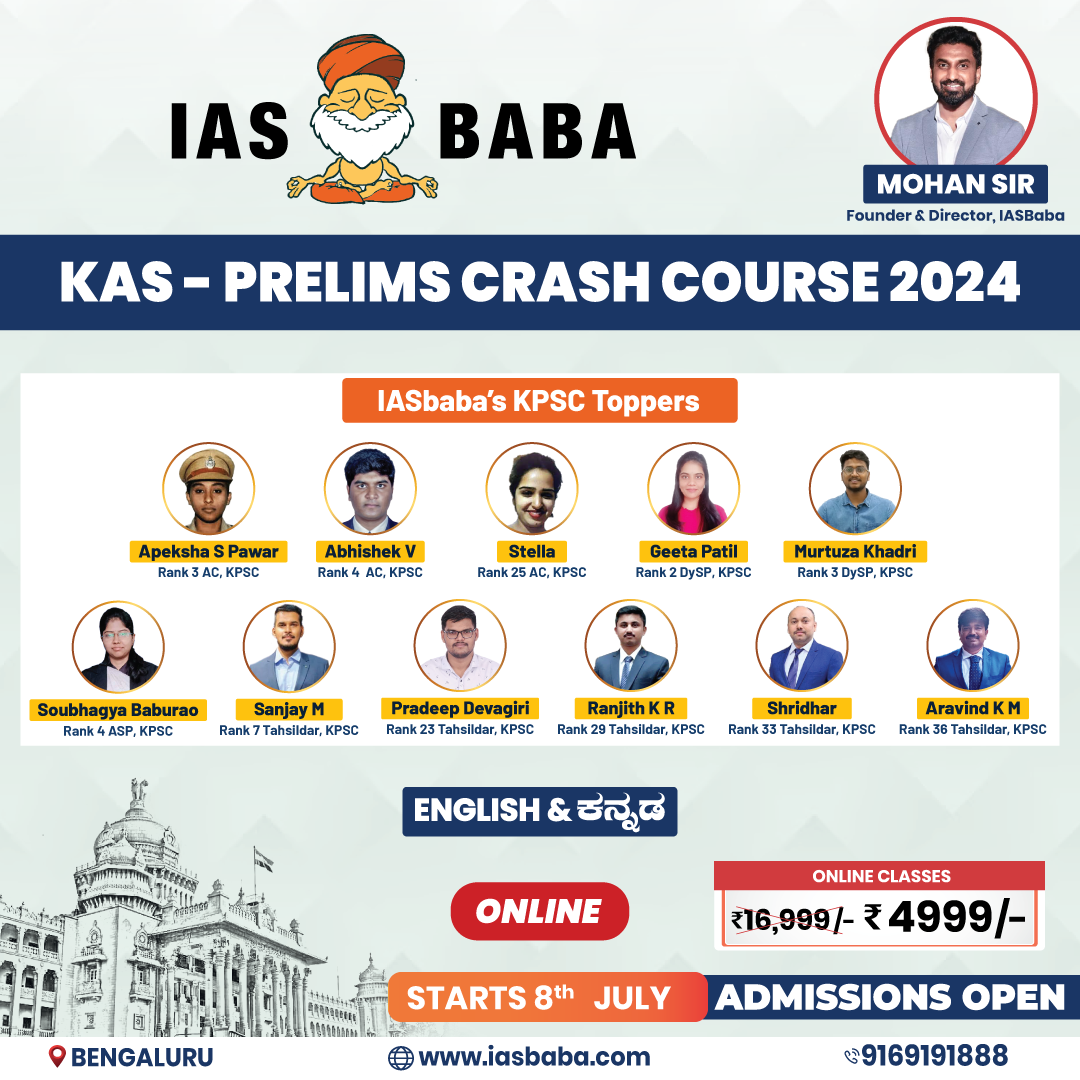IASbaba's Daily Current Affairs Analysis
IAS UPSC Prelims and Mains Exam – 18th October 2019
Archives
(PRELIMS + MAINS FOCUS)
INDIA INNOVATION INDEX 2019
Part of: GS Prelims and GS Mains III – Economy
In News
- NITI Aayog with Institute for Competitiveness as the knowledge partner released the India Innovation Index (III) 2019.
- The aim is to create a holistic tool which can be used by policymakers across the country to identify the challenges to be addressed and strengths to build on when designing the economic growth policies for their regions.
- The Index is calculated as the average of the scores of its two dimensions – Enablers and Performance.
- The Enablers are the factors that underpin innovative capacities, grouped in five pillars: (1) Human Capital, (2) Investment, (3) Knowledge Workers, (4) Business Environment, and (5) Safety and Legal Environment.
- The Performance dimension captures benefits that a nation derives from the inputs, divided in two pillars: (6) Knowledge Output and (7) Knowledge Diffusion.
- There seems to be a west-south and north-east divide across the country. The top ten major states are majorly concentrated in southern and western India.
- Karnataka is the most innovative major state in India. Karnataka’s number one position in the overall ranking is partly attributed to its top rank in the Performance dimension.
- Sikkim and Delhi take the top spots among the north- eastern & hill states, and union territories/city states/small states respectively.
TB cases see decrease in India
Part of: GS Prelims and GS Mains II – Health
In News
- The tuberculosis incidence rate in India has decreased by almost 50,000 patients over the past one year, according to the WHO -2019 edition of the Global Tuberculosis (TB) report
- The report notes that in 2017, India had 27.4 lakh TB patients which came down to 26.9 lakh in 2018.
- TB Incidence in India per 1,00,000 population has decreased from 204 in 2017 to 199 in 2018.
- The number of patients being tested for rifampicin resistance has increased from 32% in 2017 to 46% in 2018.
- However, the treatment success rate has increased to 81% for new and relapse cases (drug sensitive) in 2017, which was 69% in 2016.
Do you know?
- TB remains the top infectious killer in the world claiming over 4,000 lives a day
- Nikshay Aushadi Portal is a web-based application for the management of Anti-Tuberculosis (TB) Drugs and other commodities under Revised National Tuberculosis Control Program (RNTCP).It is implemented by Union Ministry of Health & Family welfare
FATF may keep Pakistan on grey list
Part of: GS Prelims and Mains GS-III – Economy
In News
- Pakistan could escape being blacklisted by the Financial Action Task Force (FATF) but the country is likely to be issued strong warnings and put under pressure
- Blacklisting unlikely given support of China and Malaysia
- If not downgraded, Pakistan is expected to be kept under ‘significant and sustained’ pressure to deliver on the action plan by February 2020
- Asia-Pacific group assigned a National risk rating of “medium” to the country on counter-terror financing and anti-money laundering
- The report by Asia-Pacific group says that Pakistan had taken positive actions against these organisations “but UNSCR 1267 is not being fully implemented”
- The Grey listing means downgrading of the country by multilateral lenders like IMF, World Bank, ADB, EU and also a reduction in risk rating by Moody’s, S&P and Fitch.
About FATF
- It was established in 1989 to set standards and promote effective implementation of legal, regulatory and operational measures for combating money laundering, terrorist financing and other related threats to the integrity of the international financial system.
- The FATF currently comprises 37-member jurisdictions and 2 regional organisations (the Gulf Cooperation Council or GCC, and the European Commission)
TULAGI ISLAND
Part of: GS Prelims and GS Mains I – Geography
In News
- A Chinese company has signed an agreement to lease an entire island in the Solomon Islands.
- Tulagi, an island about two square kilometres with a population of 1,200, is the site of a former Japanese naval base and was the scene of fierce fighting in World War II.
- The island of Tulagi served as a South Pacific headquarters for Britain and then Japan. During Second World War, its natural deepwater harbour across from Guadalcanal was coveted by the military.
- The agreement with state-owned China Sam Enterprise Group mentions developing special economic zone and a refinery on the island
- But the island’s port and its potential for dual use as a Chinese military base is certain to raise concerns with the United States and Australia.
- Recently, China and the Solomons officially established diplomatic relations after China persuaded the impoverished Pacific nation to sever ties with Taiwan and become its ally.
(MAINS FOCUS)
ECONOMY
TOPIC: General Studies 3:
- Indian Economy and issues relating to planning, mobilization of resources, growth, development and employment.
- Inclusive growth and issues arising from it.
Randomized controlled trial
Context:
- The 2019 Sveriges Riksbank Prize in Economic Sciences in Memory of Alfred Nobel has been awarded jointly to Abhijit Banerjee, Esther Duflo and Michael Kremer “for their experimental approach to alleviating global poverty”.
- The three adopted an evidence-based approach to apply theory to real-life situations using randomised trials and assessing the outcomes.
- The effort was to understand the impact of interventions to achieve desirable outcomes.
Randomized controlled trial
- A randomized controlled trial is a type of scientific (often medical) experiment that aims to reduce certain sources of bias when testing the effectiveness of new treatments;
- This is accomplished by randomly allocating subjects to two or more groups, treating them differently, and then comparing them with respect to a measured response.
- One group—the experimental group—has the intervention being assessed, while the other—usually called the control group—has an alternative condition, such as a placebo or no intervention.
- The groups are followed under conditions of the trial design to see how effective the experimental intervention was.
- Treatment efficacy is assessed in comparison to the control. There may be more than one treatment group or more than one control group.
- Back in the late 1990s, this was not a well-known concept, let alone a widely practised research method. Moreover, research in economics was still largely theoretical although the shift in a more empirical direction had already started.

IAS UPSC Prelims and Mains Exam – 18th October 2019
RCTs use the following insight:
- You select two groups that are similar and then randomly select one to receive the treatment (a drug, or a policy) being tested and then compare the outcome of this group (called the treatment group) with that of the other group (called the control group).
- If the difference is statistically significant, then that is attributed to the treatment. Using this method in economics has altered our views about what policies work and what do not.
Application:
- From testing drugs to placing government programmes as well as those carried out by NGOs on a randomised basis across villages, households, and organisations, takes quite a leap of imagination.
- The reason it caught on in academic research in economics is because with greater computing power and large data-sets that were available, empirical work was in ascendance and yet, given the nature of data that is collected in usual surveys, it is hard to establish the effect of any programme on any outcome in a rigorous way.
- Applied to study problems at the micro-level where the implementation of an individual programme can be done in a randomised way that allows for a statistically satisfactory evaluation of the programme’s impact.
Criticism:
- RCTs are not feasible, which is often the case with more large-scale macro-level questions, one has to rely on other, more roundabout methods to overcome the problem of causal inference.
- Broad macro-level issues or the more long-run aspects of development and institutional change, they are not feasible
Contemporary RCTs :
- A new generation of RCTs are going beyond programme evaluation and asking how individuals react to change in prices, contracts, and new information in the context of specific markets such as land or credit.
- For example, a recent RCT offered different terms of sharecropping contracts in a randomised way to find out the effect of higher crop-shares on agricultural productivity in the context of tenancy. The evidence suggested significant productivity gains, confirming the importance of incentives.
Case study:
- ‘Operation Barga’, the tenancy reform programme carried out in West Bengal by the Left Front government in the late 1970s and early 1980s, which shifted crop-share up. In that study, there was no way of fully controlling for all other factors that had changed contemporaneously, such as empowering panchayats.
- This is an example of how RCTs can be potentially applied to a broader set of issues going beyond programme evaluation.
Limitations:
- They can establish what works, but cannot say much about what could have worked better or whether it could work in a very different environment.
- Solution: see how they can be combined with theoretical models to simulate the effect of alternative policies or what could happen in a very different environment.
Conclusion:
- This method now has become one of the main tools used in empirical work in development economics and in related fields. It has also led to a paradigm shift in development policy evaluation — the World Bank, and many governments and large NGOs now insist on randomised control methods wherever feasible.
Connecting the dots:
- Despite limitations, the use of randomised control trials has led to a paradigm shift in development policy evaluation. Justify
ECONOMY
TOPIC: General Studies 3:
- Indian Economy and issues relating to planning, mobilization of resources, growth, development and employment.
- Inclusive growth and issues arising from it.
The economic slowdown in the country
Data:
- Private consumption has contracted and is at an 18-quarter low of 3.1%
- Rural consumption is in a deep southward dive and is double the rate of the urban slowdown
- Credit off-take by micro and small industries remains stagnant;
- Net exports have shown little or no growth;
- GDP growth is at a six-year low with the first quarter of FY20 registering just 5%;
- Unemployment is at a 45-year-high.
- The IMF expects global economic growth to be just 3% this year, the lowest since the 2008 global financial crisis
Causes:
- The trigger was probably the trade slowdown. Recently, the WTO also indicated that world trade growth would be 1.2% , down from 3%. So, a very anaemic or even a flat growth rate in trade is pulling down the economy.
- Because this is the age of global integration, all economies get affected.
- The trigger also lies in the protectionist tendencies of world economies and the U.S.-China trade war.
- India is also affected by this and other domestic issues.
- Emerging market economies started showing some weaknesses. Brazil and South Africa have already got into the recessionary stage.
- China started slowing down although there are many who say it is deliberate to reduce the overheating the economy was facing.
India’s case:
- India is that compared to 2008, we are not immune to global slowdown. In fact, in 2008 we were growing faster. That is the main worry for us.
- As the Indian economy has gradually opened up since 1991, the global economic situation has had spillovers in India.
- Between 2003 and 2008, the Indian economy was averaging between 8% and 9% growth. After the collapse of Lehman Brothers, it came down to 6.2%, but we were very solid.
- Non-Banking Financial Companies [NBFC] crisis has affected the flow of credit to capital goods. The demand for capital goods is down, as is car sales. Real estate is in trouble. This has resulted in a spillover in the rest of the economy.
- There is a slump in demand.
- Public investment is very critical.
Criticisms:
- India’s exports have not been able to keep pace with expectations, especially in labour-intensive sectors like textiles, where Vietnam and Bangladesh have surged ahead.
Way forward:
- We have to worry about fiscal stimulus, not fiscal consolidation.
- Then there should be some kind of social spending which affects people in need with a high propensity to consume.
- Any cash reaching the poor will find its way into the market quickly.
- Address the inequalities in recent times.
- Indian industry has grown with the comfort of having a large domestic market.
- We need to nudge industry to look at global and regional markets, especially for labour-intensive goods.
- We need to avoid the appreciation of the rupee if we are to strengthen the domestic manufacturing industry.
- Any appreciation of the rupee facilitates more imports and less exports, adversely affecting domestic production.
Eastern trade:
- The dynamism in world trade is in the Eastern side. The Western markets are really flat. There is also a rise in protectionism.
- In such a situation, we need to tap the Asian markets. In that context, RCEP [Regional Comprehensive Economic Partnership] is an important initiative.
- It gives us a possibility to integrate the Indian economy and production with the value chains in east-Asian countries.
Connecting the dots:
- What can India do to overcome the global slowdown? Examine.
(TEST YOUR KNOWLEDGE)
Model questions: (You can now post your answers in comment section)
Note:
- Featured Comments and comments Up-voted by IASbaba are the “correct answers”.
- IASbaba App users – Team IASbaba will provide correct answers in comment section. Kindly refer to it and update your answers.
Q.1)Nikshay Aushadi Portal often seen in news is predominantly associated with which of the following area?
- Provision of cheap Generic drugs
- Revised National Tuberculosis Control Program
- Tracking of imports of Active Pharmaceutical ingredients
- None of the above
Q.2)Consider the following statements about the Wold Health Organisation -2019 edition of the Global Tuberculosis (TB) report
- TB remains the top infectious killer in the world claiming over 4,000 lives a day
- TB Incidence in India per 1,00,000 population has decreased from 204 in 2017 to 199 in 2018.
Which of the statement(s) given above is/are correct?
- 1 only
- 2 only
- Both 1 and 2
- Neither 1 nor 2
Q.3)India Innovation Index is released by which ministry/body?
- Niti Aayog
- Ministry of Commerce
- World Economic Forum
- None of the above
Q.4)Tulagi islands often seen in news is located in which region?
- Mediterranean Sea
- Indian Ocean
- Pacific Ocean
- South China Sea
MUST READ
Awaiting the verdict: On Ayodhya dispute
The secondary monsoon: On rainfall behaviour
The dominant caste dilemma
A law alone will not serve as a panacea against torture by police in India
Why China’s growth has slowed to a record low?
















